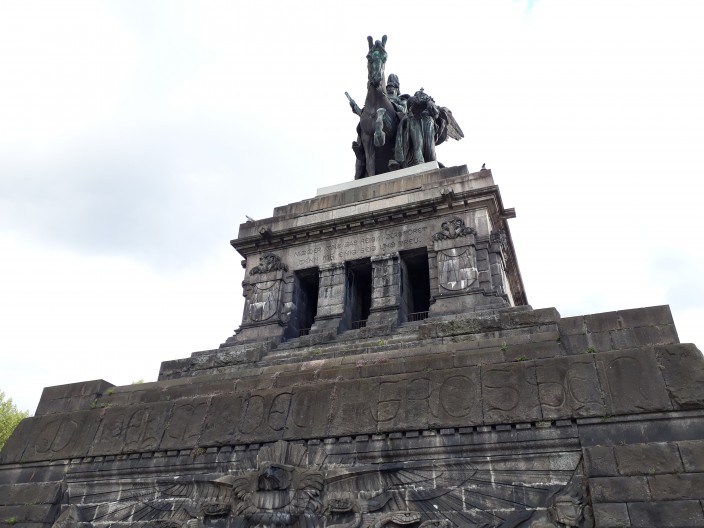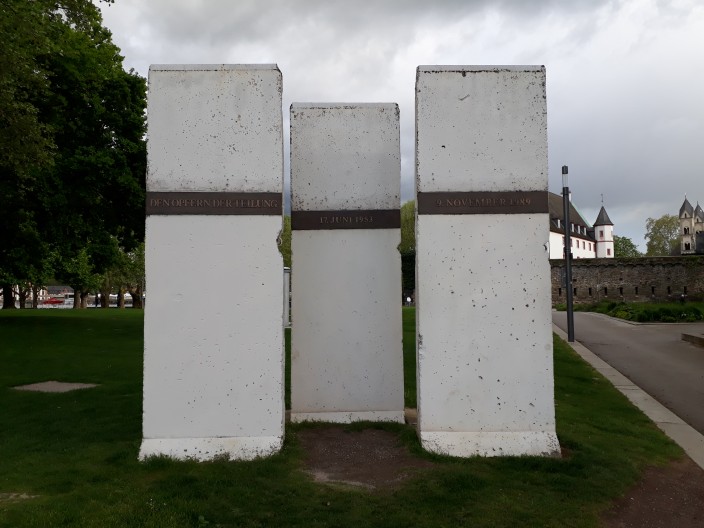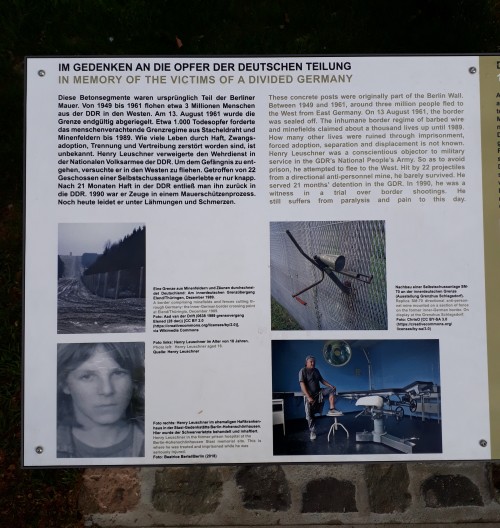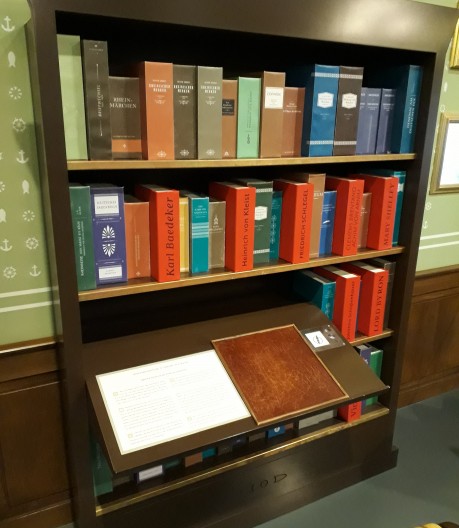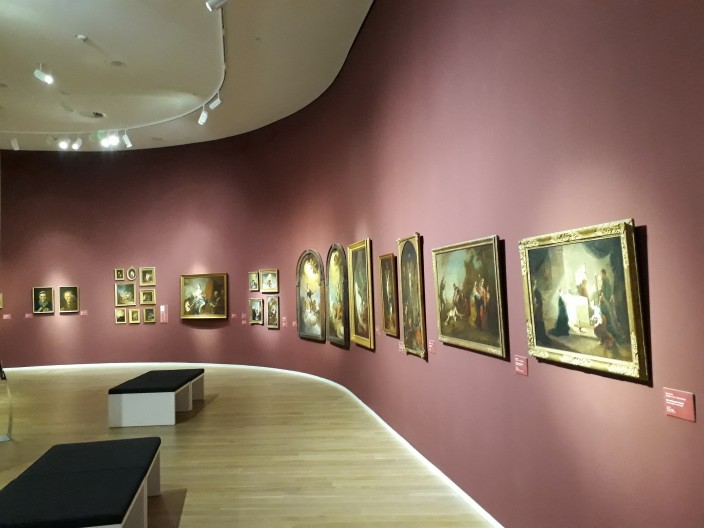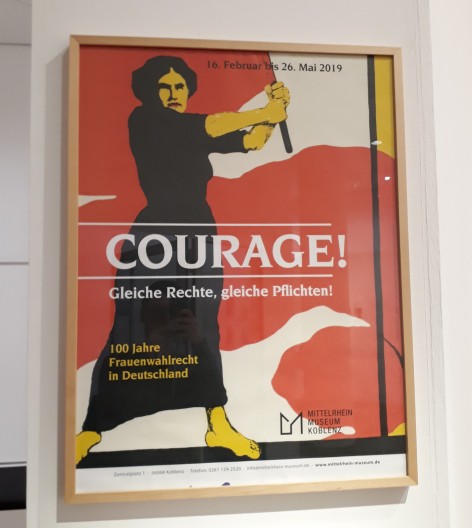Until a couple of months ago, Koblenz had never been on my list of potential places to visit. As I was doing some progress on sources related to cultural policy during the German occupation in Luxembourg, I thought that I might also take a look elsewhere than at the National Archives in the Grand-Duchy. During the occupation, Luxembourg was attached to the Gau Moselland, with Koblenz as the main headquarters of the Gauleiter Gustav Simon. Hence, I reckoned that I might discover more sources at the Landeshauptarchiv in Koblenz.
Archival research at the Landeshauptarchiv
For me, it was the first time ever to visit an archive outside of Luxembourg; my topics have always been related to the Grand Duchy and thus did not entail the necessity to visit archives abroad. Overall, it was certainly a positive experience. I liked working at the Landeshauptarchiv; the staff was very helpful and the procedure of reservation and consultation was uncomplicated (even if it was not possible to reserve in advance via the online catalogue).
In hindsight, it is difficult for me to say whether the archival research as such – the main purpose of my trip, after all – has been a success or not. For the consultation itself, I did much better progress than I had expected, which gave me the opportunity to request folders that were not on my priority list. As for the content, the information, and the relevance of the sources, the picture becomes less evident. A clear evaluation will only be possible once I have analysed all the photographed documents in detail, but I would guess that, in general, the large majority of the sources I found were not as relevant as I had hoped. Yet, at the same time, I gained some interesting and surprising insights (though these insights are not necessarily new to other researchers). A series of sources show, for instance, that in 1938/39, the Grand Duchy tried to get rid of German citizens who had psychological troubles, because they were non-nationals and considered to be a burden to society. Luxembourg’s policy of expulsing these patients confirms the nationalist wave of that time. While it would be necessary to check whether this happened with other foreign patients (such as French or Belgians), it might be potentially linked to the anti-German attitudes in Luxembourg; every reason to get rid of Germans would be, in this case, a welcome opportunity for the authorities.
Besides this aspect, I stumbled upon innumerable reports written by informants in Luxembourg (Belgium and France, too), and sent to the German Sicherheitsdient (SD). These SD reports discuss a vast range of topics: political situation, economy, military, infrastructures, press, etc. The reports I saw covered the period of the months before the invasion until after the invasion. Many of them capture the mood of the population in Luxembourg, such as the fears of a forthcoming German invasion, or the anti-German attitudes of the “intellectuals”. I would say that these reports represent the majority of the documents I consulted. Admittedly, they are not a new discovery in Luxembourgish historiography (other researchers have analysed them, too). Nevertheless, I will need to examine them in detail, as they are potentially useful.
A small part of these reports concerned the organisation of travels to Germany in which young Luxembourgers participated. The reports were not only providing details on the travels themselves, but also evaluations of the young participants – their ideological views, their character, their motivation, etc. I would like to include these sources in my thesis, as they show (in addition to other initiatives), that Germany was promoting some kind of cultural policy in Luxembourg or with Luxembourgers before the invasion.
Places of remembrance and history
As I had spent several days in a foreign city and made good progress with my archival research, I did not want to miss the opportunity to explore Koblenz, visit museums, doing sightseeing, and learn something about its history. Though I might not have learnt as much about the city’s past as I hoped, there were enough aspects that struck me and made me reflect on the use and representation of history and on places of remembrance. The first aspect concerns the presence – or rather the memory – of Joseph Görres. I discovered this name for the first time during my research on the interwar period and my readings on the Westforschung1: in 1937, the Luxembourgish teacher and writer Nicolas Welter received the Görres-Prize, which was awarded by the University of Bonn, where many of the Westforscher were teaching or researching. I knew therefore the name, but I did not know the person’s biography. Indeed, Joseph Görres (1776-1848) was a Catholic publicist and born in Koblenz. Hence, his birthplace has dedicated a square (Görres-Platz), a high school (Görres-Gymnasium), a street (Görresstraße), and a monument (Görres-Denkmal) to him. It is nearly impossible to visit Koblenz (or to look at Koblenz on Google Maps) and not stumble upon his name.
While Görres' presence is probably not what Koblenz is known for, two other landmarks have become important tourist attractions of the city. The first one is the Deutsches Eck (“German Corner”), an artificially raised land tongue at the conjunction of the rivers Moselle and Rhine. In fact, the name Koblenz is derived from the Latin “Castellum apud Confluentes”.2 Visually, the Deutsches Eck is dominated by the impressive monument in honour of the first German Emperor William I. Its history illustrates how such places and monuments can become objects of debates and changing significations. The large monument – the stone pedestal and the statue – was constructed several years after William’s death. In 1945, the equestrian statue was destroyed by artillery fire. In the post-war period, the German authorities decided to attribute a new meaning to the monument, turning it into a memorial for German reunification. The German national flag was placed on the pedestal. In 1993, after the two Germanies were reunified, a replica of the original equestrian statue, financed by a private sponsor, replaced the flag. The plans to reconstruct an imperial symbol elicited public debates on the meaning of and the problems surrounding the monument. As Marco Zerwas observes in his blogpost about the monument, considerations of touristic value and nostalgic feelings were able to assert themselves against an “established national memorial site”. To me, the reconstructed monument seemed to appear rather out of touch with the late 20th and the 21st centuries (I had to think back to a discussion at the Kulturpolitischer Bundeskongress in 2017 on a Bismarck statue in Hamburg, criticised because of the imperial and colonial past it represents3). But it was not the only aspect that struck me. Indeed, if one might argue that the statue is out of touch with our present, the three panels of the Berlin Wall, erected in its vicinity, are certainly out of place. They are an interesting example of how something can be removed from its original location, transplanted several hundreds of kilometres away, and filled with new meaning. Still in the context of the German division and reunification, the panels should now remember the victims of this very division. It makes me wonder whether the Deutsches Eck is actually not a site remembering two unifications a century apart; the one created in war, the other created without war but after decades of human suffering?
- 1. See for instance: THOMAS Bernard, Le Luxembourg dans la ligne de mire de la Westforschung. Luxembourg: Editions d'Letzeburger Land, 2011.
- 2. https://www.koblenz-touristik.de/kultur/sehenswertes-koblenz/deutsches-e... [Last access: 10/05/2019].
- 3. I mentioned this discussion in the blogpost I wrote about the Kulturpolitische Bundeskongress.
While I’m not sure if the tourists visiting Koblenz and specifically the Deutsches Eck are always aware of the peculiar irony linked to its meaning, it has undoubtedly become a tourist attraction and a landmark of the city. Another tourist magnet is the fortress Ehrenbreitstein, on a hill on the opposite side of the Rhine. Constructed in the 18th century by the Prussians (though there are traces of previous settlements dating back to Antiquity), it was a strategically important place. Once used for warfare, it houses nowadays the Landesmuseum and a youth hostel, it serves as a location for major cultural events, and it can be reached by cable car, itself promoted as a touristic experience. When I was in Koblenz, I had the opportunity and the fortune to visit the fortress for the Festungsleuchten, a light festival which exists in similar versions in other cities (lights and lasers illuminating facades or public spaces). While it was certainly interesting to visit, I thought that a lot of potential remained unused. The larger theme connecting the installations was Romans (or Roman antiquity), but it was not always clearly visible or understandable. Unfortunately, the Landesmuseum was already closed when I got there, but I could visit two other museums in Koblenz.
Touristic propaganda and spaces of charismatic ideology
The two museums I visited are located in the Forum Confluentes, a modern building in the centre of Koblenz. The first one was the Romanticum, presenting the region around Koblenz and the Rhine valley. It should place the visitor in the skin of a traveller and exhibit how the Romanticists of the 19th century viewed the region (Rheinromantik). It is promoted as an interactive museum, with different stations that allow for several activities, such as listening to stories, taking pictures, moving objects, etc. Every visitor receives a card on which the stories and information can be saved and, later, retrieved on a webpage via an individual code. While the museum might provide a nice experience for families (though I’m not sure if children have the patience to listen to the innumerable stories – I certainly did not), I could not get rid of the feeling that it was merely a better and interactive version of a tourist brochure. One room made this especially clear, focusing on biking tours in the Rhine valley. Another station allowed to explore the landmarks and tourist destinations in the region and to collect them with the card (of course, to visit them later physically). The exhibition was clearly conceived as some sort of appetizer for further exploring the valley and thus promoting tourism. This aim was combined with some teaching and education, such as the histories behind the castles in the Rhine valley, or the nature and geology of the area. While often adopting a more child-friendly presentation, it was always done in a way to showcase the region instead of inciting critical thinking. Unsurprisingly, the latter is often the first victim when it comes to promoting tourism (see the monument of William I).
The second museum I visited was the Mittelrheinmuseum. The museum’s permanent exhibition constitutes a fitting example of what Pierre Bourdieu and Alain Darbel called “charismatic ideology” (I have discussed it in another blogpost in the context of digital history). The art collection reaches from medieval times to the contemporary period. While the objects were arranged according to periods, creators, movements or themes, an average visitor with no background in art history will not be able to relate to the exhibits, to grasp, analyse, or contemplate them. I had the impression that the organisers of the exhibition used as much wall space as they could to exhibit as many artworks as they could. A lot of didactic potential is lost. The only possibility to learn a bit more were printed DIN A4 information sheets which were easy to overlook (I don’t remember if the museum offers audio guides, but this, too, is in my opinion not an excuse to make the exhibition itself less didactic). In one room at the beginning of the tour, at least half a dozen statues of Maria were standing next to each other. They showed some commonalities, some differences. This is one example of lost potential: why not add more context to help decode these statues? As I have no background in art history, and know even less about medieval art, I was not able to analyse the objects. My intellectual capacity was reduced to what I see, and not extended to what I understand. It seems that the faith in the charismatic ideology of the artworks, that it suffices to look at them to assimilate or get (intellectual) access to them, was very strong when the permanent exhibition was conceived.
Though I did not enjoy the permanent exhibition (partly due to my own ignorance of the artworks), I liked very much the temporary exhibition Courage on voting rights for women in Germany, created in cooperation with the Frauenmuseum in Bonn. Contemporary artworks or art installations were combined with a historical exhibition. Explanation panels help to understand the artistic exhibits, which approach the topic in a critical perspective (the place of women in past and today’s societies). As for the historical part, the context and background information on the voting rights for women is very insightful, even if the exhibition uses the traditional methods of wall texts and illustrations. While I am not an expert on this topic, I think the exhibition succeeded in providing a complex and rich picture of the struggles that took place, the resistances against these struggles, and the diverging views within the women’s rights movements in Germany.
The travelling historian
The days I was spending in Koblenz turned out to be full of surprises and thought-provoking moments. I had the opportunity to explore archives and discover interesting documents, to see monuments filled with new meanings, to visit historical sites turned into touristic destinations, and to roam in museums. It makes me wonder what kind of traveller I was (something between a historian doing his work and a tourist enjoying views?). In a certain way, I was constantly travelling between present and past, between history and remembrance, between fact and imagination.



